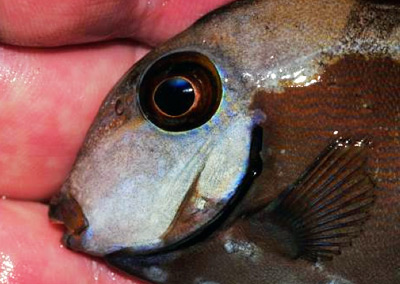Many different factors have been considered as possible causes of the disease known as Head and Lateral Line Erosion (HLLE)—a condition that typically causes disfiguring tissue erosion on the head and along the sensory lateral line of certain marine fishes. Poor water quality, nutritional deficiencies, protozoa of the genus Hexamita, stray voltage, and activated carbon use are just some of the potential causes that have been floated over the years.
However, as Jay Hemdal explains in the following excerpt from his new eBook, The Salt Smart Guide to Preventing, Diagnosing, and Treating Diseases of Marine Fishes, there is now some solid scientific backing to the notion that activated carbon can cause this condition.
From Chapter 3: Husbandry, Environment, and Your Fishes’ Health
“A relationship between the use of activated carbon in aquariums and the development of HLLE in surgeonfish has been positively shown in two scientific studies. Other than that, no formal studies have been undertaken that identify other causes. However, a multitude of unproven causes have been presented by various people. Commonly, stray electrical currents and vitamin deficiencies are cited as causes, but one of the studies mentioned above ruled these out as common causes.
Based on those preliminary observations, the Toledo Zoo performed a study that demonstrated that, indeed, lignite carbon causes HLLE in surgeonfish. Minor HLLE lesions were noted on two study fish 20 days after the lignite carbon was added to the sump of their system. The lesions began to develop on the additional fish in that system and grew in size until after four months, all of the fish in that system showed severe lesions (eventually involving over one-third of their body surface). The control fish did not develop any lesions.
The carbon study hypothesis
The basic hypothesis of this study was that activated carbon causes HLLE in fishes. Originally, it was thought that carbon dust (known as fines) was the causative agent. This was based on observations at the Toledo Zoo where carbon was removed from an aquarium and the water was changed, yet HLLE symptoms could still be produced by adding susceptible fish to the aquarium, indicating there was some unknown residual action by the carbon.
Carbon fines were frequently discovered in the filter sumps and substrate of these tanks. Changing all of the aquarium’s water, decorations, and substrate would then render the aquarium safe for housing susceptible fishes (assuming no new carbon use).
Two public aquariums have reported acute outbreaks of HLLE in systems where carbon had been accidentally ground up and ejected into aquariums by mechanical filtration systems. It has also been reported that aquariums that use protein skimmers (foam fractionators) do not seem to develop HLLE as frequently, even when carbon is routinely used. Since protein skimmers remove particulate organic carbon from water (including carbon fines), it was thought that this might be the reason these systems do not cause HLLE as readily.
In addition, the hard-pelleted carbon used in this study did not cause severe HLLE, while the soft, dusty carbon did. However, no carbon fines were seen during histological examinations of the lesions of the study fish. This means either that the dust causing the effect is fleeting, the fines were too small for the histologist to see, or there is some other factor associated with carbon use that causes HLLE in susceptible fishes.”



